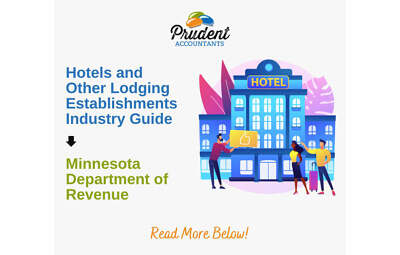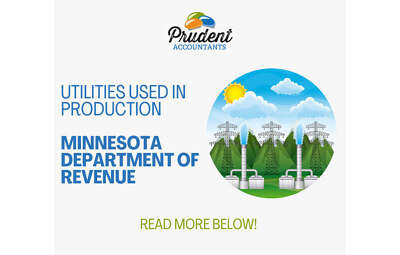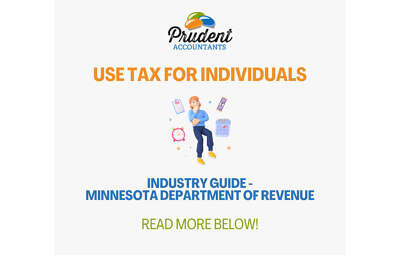Prepared Food – Industry Guide – Minnesota Department of Revenue
Taxable Sales
Prepared food is taxable. There are three separate ways that a food or drink item can become prepared food:
- The food or drink is sold in a heated state or heated by the seller, regardless of serving size
- Two or more food ingredients are mixed or combined by the seller for sale as a single item, regardless of
serving size - Eating utensils are provided by the seller (if your prepared food sales exceed 75%, utensils need only to be
made available)
Nontaxable Sales
The following items, even though they may match the descriptions under the first two bullet points above, are not prepared food, unless sold with eating utensils provided by the seller:
- Bakery items
- Food that requires cooking prior to consumption
- Ready-to-eat meat and seafood in an unheated state sold by weight
- Raw eggs, fish (including shellfish from the sea), meat, poultry, and foods containing these raw animal foodsrequiring cooking by the consumer so as to prevent food borne illnesses
- Food that the seller only slices, repackages, or pasteurizes
Definitions
Bakery items – bakery items include:
- Bagels
- Bars
- Biscuits
- Bread
- Buns
- Cakes
- Cookies
- Croissants
- Danish
- Donuts
- Muffins
- Pastries
- Pies
- Rolls
- Tarts
- Tortes
- Tortillas
- Other similar items
Note: Bakery items do not include ice cream cakes and ice cream pies.
Heated state – heated state includes:
- Baking
- Braising
- Boiling
- Broiling
- Dehydrating
- Frying
- Microwaving
- Roasting
- Simmering
- Smoking
- Steaming
- Other forms of warming or cooking
Note: Food that was heated by the seller at any time before the sale, is taxable as prepared food even if it is in an unheated state at the time of the sale.
Mixed or combined by the seller – When the seller creates a single item for sale by adding two or more items together. The combining or mixing may occur at premises other than the location where the sale is made. This does not include when the seller contracts with another legal entity to mix or combine the food ingredients.
Sliced, repackaged, or pasteurized food – Food the seller does not prepare other than to slice, repackage, or pasteurize.
Seller – The legal entity that sells the food item at retail.
Eating utensils – A useful tool or instrument used in the consumption of food including:
- Bowls
- Chopsticks
- Cups
- Forks
- Glasses
- Knives
- Napkins
- Plates
- Platters or trays designed for serving and displaying the food
- Skewers inserted into food and handed to thecustomer
- Spoons
- Straws
Note: Eating utensils does not include material that is used solely to package and transport food.
Provided by the seller – Eating utensils are provided by the seller when either the seller:
- Physically gives or hands the eating utensil to the customer
- Makes the eating utensils available to the customer, such as placing them on a counter or in a service area(other than placing the utensil on a surface next to where a customer sits or stands to eat)
75% Calculation
The 75% calculation is used to determine if food is taxable prepared food when a seller makes eating utensils available to customers. If the prepared food percentage is greater than 75%, then all food sold will be taxable as prepared food if the seller makes available eating utensils. See below for the exception for a food item that contains four or more servings packaged as one item for a single price. However, if the seller physically gives the eating utensils to the customer, then the food will be taxable as prepared food, regardless of the prepared food percentage, and regardless of the item containing four or more servings sold as one item.
A seller that makes eating utensils available to their customers must calculate their prepared food sale percentage every year. If the seller has multiple locations, they must calculate one prepared food sales percentage for all of their combined Minnesota establishments. This includes all business operations in Minnesota owned by the same person.
Examples
- A partnership owns two restaurants in Minnesota. The partnership must combine sales from both restaurantsto calculate the prepared food sales percentage.
- A partner from the restaurant in the above example, also is a sole proprietor of a grocery store. The grocery store sales are not combined with the restaurant sales because it is not owned by the partnership.
Calculating the Percentage
Determine if you will use the previous tax year or the previous business fiscal year to calculate the percentage. Follow the steps below to calculate the percentage.
1. Total all sales of taxable food where:
a. the seller prepared the food by heating, or mixing or combining ingredients
b. plates, bowls, glasses, or cups are necessary to receive the food
Do not include sales of alcoholic beverages in this calculation.
2. Total all sales of:
a. food and food ingredients
b. prepared food
c. candy
d. dietary supplements
e. soft drinks
Do not include sales of alcoholic beverages in this calculation.
3. Divide the total prepared food sales calculated in step 1, by the total sales of all food and food ingredients determined in step 2. The resulting percentage is your prepared food ratio.
Example
- A seller’s sales of prepared food for the previous year in step 1 are $150,000. Their sales of all food and food ingredients from step 2 are $172,000. The prepared food percentage is 87% ($150,000 ÷ $172,000 = 87%).
- A seller’s sales of prepared food in the previous year in step 1 are $97,000. Their sales of all food and food ingredients from step 2 are $178,000. The prepared food percentage is 54% ($97,000 ÷ $178, 000 = 54%).
Applying the Prepared Food Percentage
Sellers must apply the percentage to their food sales, where the seller makes available eating utensils, no later than 90 days after the beginning of the tax or business fiscal year.
A seller opening a new business in Minnesota must make a good faith estimate of the prepared food sales percentage for the first year. If the seller has new and existing businesses, combine the good faith estimate for the new business and the previous year data from the established businesses to arrive at a single percentage.
After the first three months of operation of the new business, the seller must calculate their prepared food sales percentage based on actual sales. If the result is different than the estimated percentage, the seller must apply the new result to future sales.
Four or More Servings
Even if the seller’s prepared food sales percentage is greater than 75%, if the food item contains four or more servings packaged as one item for a single price, utensils are not provided by the seller merely because the seller makes the utensils available (for the item to be taxable, the seller would have to have the practice of physically giving the utensils to the customer). To determine the number of servings in the food item, use the information on the product label. If there is no product label, the seller can make a reasonable determination as to the number of servings in the food
item.
Either the purchaser or the seller can place the food in the package. The food is sold for a single price if there is one price for the entire contents of the packaged food. If the seller charges for each individual serving in the package, then the sale is not one item sold for a single price.
Combination Packages
When a retailer sells a combination package consisting of taxable and nontaxable food items for a single price, the transaction may be taxable as a bundled transaction. The total sales price is taxable if eating utensils are provided by the seller.
If eating utensils are not provided, the sale is taxable if either applies:
- The taxable food item is more than 50% of the total sales price of the combination package
- The purchase price of the taxable food item is more than 50% of the total purchase price of the combination
package
For more information, see the Food and Food Ingredients Fact Sheet.
Prepared Food Flowchart
We also have a flow chart on our prepared food information. To view the flow chart, go to our website at www.revenue.state.mn.us and type Prepared Food Flowchart in the Search box.
Prepared Food Examples
The chart below covers various types of prepared food scenarios and their taxability.
Food Type |
Examples |
Taxability |
| Heated food |
|
Taxable |
| Heated food |
|
Taxable |
| Heated food |
|
Not taxable |
| Mixed or combined by the seller |
|
Taxable |
| Mixed or combined by the seller |
|
Not taxable |
| Eating utensils (physically given) | When the seller’s practice is to physically provide eating utensils, the food becomes taxable prepared food regardless of serving size. This includes:
|
Taxable |
| Eating utensils (made available) | When eating utensils are not physically given to the customer, the food becomes taxable prepared food when the seller makes the utensils available under the following circumstances:
|
Taxable |
| Ready-to-eat meat and seafood in an unheated state sold by weight |
When eating utensils are provided by the seller, ready to eat meat and seafood items become taxable prepared food.
Ready to eat meat and seafood is also taxable prepared food when the seller mixes additional ingredients that are not part of the ready-to-eat meat and seafood item, for example adding celery or pasta to make cold salads |
Taxable |
| Ready-to-eat meat and seafood in an unheated state sold by weight |
When eating utensils are not provided by the seller, ready-to-eat meat and seafood in an unheated state sold by weight are not taxable.
Examples include:
|
Not taxable |
| Food requiring additional cooking prior to consumption |
Food that would be taxable prepared food because two or more ingredients were mixed or combined by the seller, or because the food was at some time heated by the seller, is not taxable when additional cooking is required (as opposed to just reheating) by the customer prior to eating, for example a partially baked pizza. |
Not taxable |
| Combination Packages | Example
The sales price of the chicken is more than 50% of the total cost of the combination package. The sale is taxable. |
Taxable |
For more detailed and specific information on Prepared Food, you can visit at Prepared Food – Industry Guide – Minnesota Department of Revenue







